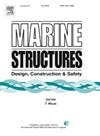Non-linear dynamic behavior of T0 and T90 mesopelagic trawls based on the Hilbert–Huang transform
IF 4
2区 工程技术
Q1 ENGINEERING, CIVIL
引用次数: 0
Abstract
Although adopting the T90 mesh orientation on the trawl net can improve the selectivity of the trawl codend, it is unknown whether the T90 mesh orientation influences the dynamic behavior of the trawl system. Therefore, this study uses non-linear dynamic analysis to examine the effect of mesh orientations, mesh size, and twine diameter on the mesopelagic trawls' fluttering motions and hydrodynamic force responses. Three trawls are designed with different mesh orientations (T0 and T90), mesh sizes (40 mm and 60 mm), and twine diameters (0.96 mm and 1.11 mm) on the codend and codend extension sections of the trawl model based on Tauti's law. These trawls are tested in a flume tank under various flow velocities and catch sizes. A time-frequency analysis method based on the Hilbert–Huang transform is utilized to analyze each trawl's dynamic responses, including motions and drag force responses. The results are compared with those obtained through Fourier analysis using power spectral density. The results highlight that the oscillation amplitude of the surge motion of the T90 trawl is higher than that of the T0 trawl. In contrast, the T90 trawl's heave motion oscillation amplitude is smaller. The dominant frequency of the periodic high-energy coherent structures of the surge and heave motions are detected at a low frequency. The surge and heave motions of the T0 trawl have a greater response to the current components with lower frequencies than that of the T90 trawl. An increase in mesh size, a decrease in twine diameter, and a change in mesh orientation decrease the drag force. The inherent characteristic oscillations of the drag force response for the three trawl models are synchronized with the low-frequency characteristic of surge and heave motions. The gravity periods of the low-frequency mode components of drag force, surge motion, and heave motion for the T90 trawl are higher than those for the T0 trawls. In other words, the T90 trawl is more stable and selective than the T0 trawl. The findings of this study offer important information for comprehending and enhancing the selectivity of trawls in marine mesopelagic fisheries, particularly for exposing the effects of mesh orientation and design parameters on trawl performances.
基于希尔伯特-黄变换的 T0 和 T90 中上层拖网的非线性动态行为
虽然在拖网上采用 T90 网目方向可以提高拖网鳕鱼的选择性,但 T90 网目方向是否会影响拖网系统的动态行为尚不清楚。因此,本研究采用非线性动力学分析方法,研究网目方向、网目尺寸和麻绳直径对中上层拖网的飘动运动和水动力响应的影响。根据陶氏定律,在拖网模型的鳕尾和鳕尾延伸部分设计了三种不同网目方向(T0 和 T90)、网目尺寸(40 毫米和 60 毫米)和麻绳直径(0.96 毫米和 1.11 毫米)的拖网。这些拖网在不同流速和渔获量的水槽中进行了测试。利用基于希尔伯特-黄变换的时频分析方法分析了每种拖网的动态响应,包括运动和阻力响应。分析结果与使用功率谱密度进行傅立叶分析得出的结果进行了比较。结果表明,T90 拖网的浪涌运动振幅高于 T0 拖网。相比之下,T90 拖网的起伏运动振幅较小。探测到的浪涌和翻腾运动的周期性高能相干结构的主频较低。与 T90 拖网相比,T0 拖网的涌浪和翻浪运动对频率较低的电流成分的响应更大。网目尺寸的增加、麻线直径的减小以及网目方向的改变都会降低阻力。三种拖网模型拖力响应的固有特征振荡与涌浪和波浪运动的低频特征同步。T90 拖网的阻力、涌浪运动和波浪运动的低频模式分量的重力周期高于 T0 拖网。换句话说,T90 拖网比 T0 拖网更稳定,选择性更强。这项研究结果为理解和提高拖网在海洋中上层渔业中的选择性提供了重要信息,特别是揭示了网目方向和设计参数对拖网性能的影响。
本文章由计算机程序翻译,如有差异,请以英文原文为准。
求助全文
约1分钟内获得全文
求助全文
来源期刊

Marine Structures
工程技术-工程:海洋
CiteScore
8.70
自引率
7.70%
发文量
157
审稿时长
6.4 months
期刊介绍:
This journal aims to provide a medium for presentation and discussion of the latest developments in research, design, fabrication and in-service experience relating to marine structures, i.e., all structures of steel, concrete, light alloy or composite construction having an interface with the sea, including ships, fixed and mobile offshore platforms, submarine and submersibles, pipelines, subsea systems for shallow and deep ocean operations and coastal structures such as piers.
 求助内容:
求助内容: 应助结果提醒方式:
应助结果提醒方式:


